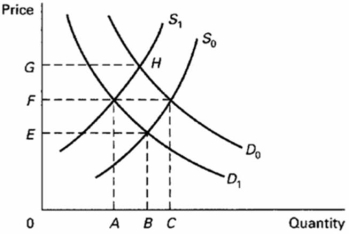A) is P = 70 - Q.
B) is P = 35 - 2Q.
C) is P = 35 - .5Q.
D) cannot be determined from the information given.
Correct Answer

verified
Correct Answer
verified
Multiple Choice
Price floors and ceiling prices:
A) both cause shortages.
B) both cause surpluses.
C) cause the supply and demand curves to shift until equilibrium is established.
D) interfere with the rationing function of prices.
Correct Answer

verified
Correct Answer
verified
Multiple Choice
Assuming conventional supply and demand curves, changes in the determinants of supply and demand will:
A) in all likelihood alter both equilibrium price and quantity.
B) alter equilibrium quantity, but not equilibrium price.
C) alter equilibrium price, but not equilibrium quantity.
D) have no effect upon equilibrium price or quantity.
Correct Answer

verified
Correct Answer
verified
Multiple Choice
When an economy achieves both allocative and productive efficiency, it implies that there is:
A) income equality.
B) price stability.
C) full production.
D) fixed technology.
Correct Answer

verified
Correct Answer
verified
Multiple Choice
Assume that the demand schedule for product C is downsloping.If the price of C falls from $2.00 to $1.75:
A) a smaller quantity of C will be demanded.
B) a larger quantity of C will be demanded.
C) the demand for C will increase.
D) the demand for C will decrease.
Correct Answer

verified
Correct Answer
verified
Multiple Choice
An effective price floor on wheat will:
A) force otherwise profitable farmers out of business.
B) result in a shortage of wheat.
C) result in a surplus of wheat.
D) clear the market for wheat.
Correct Answer

verified
Correct Answer
verified
Multiple Choice
Which of the following is true of a demand curve?
A) It shows the relationship between price and quantity demanded.
B) It indicates the quantity demanded at each of a series of possible prices during a specified time period.
C) It is downward sloping.
D) All of the choices are correct.
Correct Answer

verified
Correct Answer
verified
Multiple Choice
Refer to the table below.  If a technological advance lowers production costs such that the quantity supplied increases by 60 units of this product at each price, the new equilibrium price would be:
If a technological advance lowers production costs such that the quantity supplied increases by 60 units of this product at each price, the new equilibrium price would be:
A) $11
B) $12
C) $13
D) $14
Correct Answer

verified
Correct Answer
verified
Multiple Choice
An "increase in the quantity supplied" suggests a:
A) rightward shift of the supply curve.
B) movement up along the supply curve.
C) movement down along the supply curve.
D) leftward shift of the supply curve.
Correct Answer

verified
Correct Answer
verified
Multiple Choice
You are asked to determine, other things equal, the effects of a given change in a determinant of demand or supply for product Xupon (1) the demand (D) for, or supply (S) of, X, (2) the equilibrium price (P) of X and (3) the equilibrium quantity (Q) of X.Refer to the above.An increase in the price of a product which is a complement (in consumption) to X will:
A) decrease S, decrease P, and decrease Q.
B) increase D, increase P, and increase Q.
C) decrease D, decrease P, and decrease Q.
D) increase D, increase P, and decrease Q.
Correct Answer

verified
Correct Answer
verified
Multiple Choice
The law of demand is illustrated by a demand curve that is:
A) vertical.
B) horizontal.
C) upward sloping.
D) downward sloping.
Correct Answer

verified
Correct Answer
verified
Showing 281 - 291 of 291
Related Exams